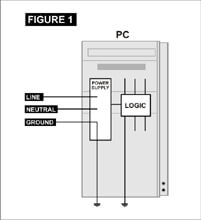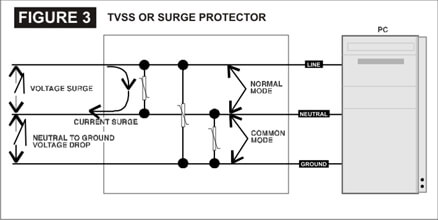Mark Waller & Associates
Chino Hills, CA
Why would anyone want to bond neutral to ground? Why wouldn’t they? In their rush to provide the highest possible levels of power protection for copiers and fax machines, power protection manufacturers have been tempted to bond the neutral and ground in their devices. The purpose of this paper is to clarify the issues surrounding the bonding of neutral to ground as prescribed by the NEC (National Electrical Code). In addition, we want to highlight the problems, or should we say hazards, associated with “Non-compliant” neutral to ground bonds.
The Great Temptation of Surge Suppressor Manufacturers
What is the “Temptation?” To short circuit neutral to ground without a transformer as required by code. Wouldn’t it be wonderful if we didn’t have to rely on TVSS devices only for Normal mode protection? Wouldn’t it be lovely if we could tie the neutral to ground together without a transformer? After all, transformer-based conditioners are hundreds of dollars while multi outlet surge suppressors are relatively cheap. This would be great. Imagine the sales slogans for such a device.
The problem is that without a transformer this device is nothing more than a non-compliant neutral to ground bond with all of the associated problems mentioned below. Read on and you will understand the radical differences between TVSSs and transformers, common mode vs normal mode as well as why bonding the neutral and ground must not happened without strict compliance to the NEC.
Power Quality
Chip damage, data corruption, errors, unwanted ground current, and dangerous touch voltages are all common problems associated with non-compliant NG Bonds. But NEC compliant NG Bonds can be a good way of solving many power quality problems. To understand this we need to look at normal mode vs. common-mode, power quality events.
In figure one we see there are three wires connecting the device, the line (black wire), the neutral (white wire), and the ground wire. If we were to take a voltmeter and measure from the line to neutral we would see there is a potential difference of 120 volts rms. We see this because this is the mode that we normally see utility voltage, thus “normal” mode.
[/full_quote]
Since the neutral and ground are shorted and the return paths are short, there is not voltage drop created by the operation of normal mode suppression. In order to understand why the National Electrical Code would want to bond neutral to ground in the first place, look at figure four. This clearly shows that in the case of a fault inside this piece of equipment the grounding conductor is necessary in order to provide a fault current path to open the breaker.

A number of points need to be made here. As it is intended by code, the ground conductor basically takes the place of the neutral as a return path during a fault condition. Clearly, the neutral conductor is not part of the fault current path. But what if the ground conductor did not bond to the neutral? Fault current would then have to wonder its way upstream, passing through some other power source. We don’t know if this fault path would be low enough in impedance to allow sufficient fault current to flow in order to open the breaker immediately. This is vital since touch voltages that exists for any amount of time are an extreme safety hazard as shown in figure four.
Should someone complete the fault circuit before the breaker opens, death could result. Imagine a secretary sitting at a workstation with her shoes off and her feet resting on one of those outlet covers on the floor. In my experience, this scenario is not far fetched.
Many workers receive electrical shocks under these circumstances. However, the dangerous touch voltages do not exist from faults. More often than not they exist due to wiring errors. The most common wiring error I see is an non-compliant neutral to ground bond. More on that later.
The Neutral to Ground Bond
Where is it NEC compliant to bond neutral and ground? The NEC prescribes two places. The first place that we find this bond is at the service entrance inside the main service panels. Why? Fault current at this point needs to come from the utility source.
The other place where the neutral and ground are required to be bonded is on the secondary side of what the NEC calls a “separately derived system.” The most common separately derived system is a power transformer where the primary and secondary windings are galvanically isolated from one another. This describes the NEMA type transformer widely used to distribute power inside all commercial buildings. The reason for this is simple safety. The NEC wants the transformer providing the electric current in its own distribution system to be sole source for fault current in the event of a fault in that distribution system. Fault current that does not have a short, low impedance path will not open breakers immediately.
Non-compliant Neutral to Ground Bonds
A non-compliant neutral to ground bond is usually easy to spot. Open a distribution panel and look inside. All of the branch circuit neutral wires, the white wires, terminate on a common bus. All of the branch circuit ground wires, the green wires, terminate on their own bus. If these are interconnected in any way, a violation of the NEC exists.
What are the effects of this? Look at figure five. This shows the circuit we have described. The IEEE Emerald book states that, “Improper, extraneous neutral-ground bonds are a relatively common problem that not only create shock hazards for operating personnel but can also degrade the performance of sensitive electronic equipment.”
How can you test a TVSS to see if the manufacturer has fallen to the “temptation” to non-compliantly bond neutral to ground? Plug the unit into the GFCI outlet in your bathroom or kitchen. The way a GFCI works is it looks at ground current. Anything excessive trips the breaker in the outlet. The purpose for this is in case there is a fault in a device like a shaver or hairdryer. A typical scenario that would produce a ground fault would be dropping a hair dryer in a sink full of water. Another would be to non-compliantly bond the neutral to ground!
How does a non-compliant N/G Bond create operational problems in sensitive equipment? Looking back at figure five, notice that the PC connected close to the non-compliant N/G bond is also networked to another PC. As the flow of return current splits at the non- compliant bond, we see that some of the current flows in the ground path. The relative impedance of the two paths at power frequencies will determine the amount of current flowing in the ground as opposed to the neutral. We mention “power frequencies” for a good reason. This is not 60Hz as we might normally assume. It is a complex waveform predominated by the third harmonic, i.e. 180 Hz as well as higher order harmonics.




